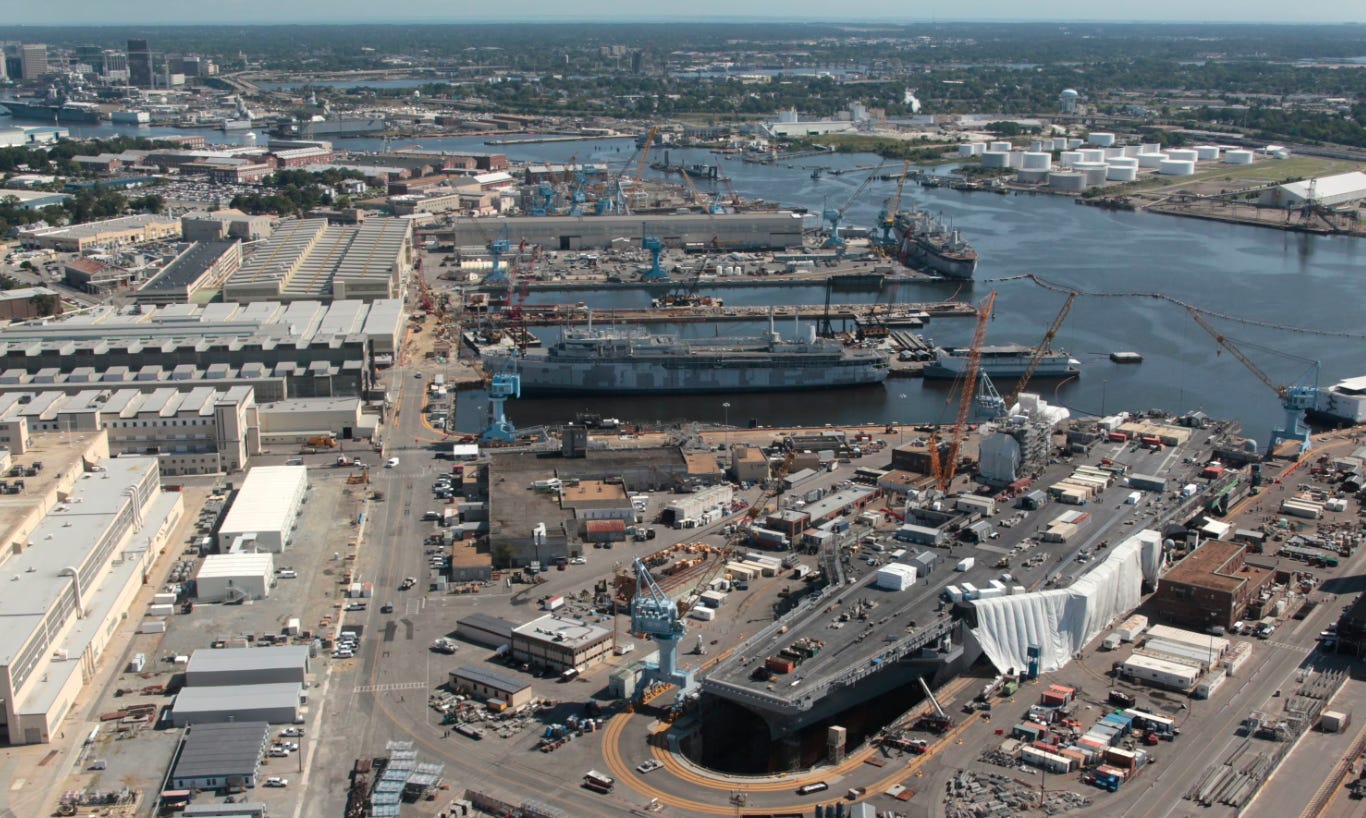Navy Force Structure and Shipbuilding: There is Still Time to Get it Right
the Navy needs to start over
The latest Shipbuilding Plan is not quite what it should or needs to be.
Why?
To answer that question and to give a call to action to help correct it is the irreplaceable Bryan McGrath.
Bryan, over to you.
Ardent U.S. navalists had a lot to chew on over the past week, as the irreplaceable Congressional Research Service (CRS) analyst Ron O’Rourke released his latest “Force Structure and Shipbuilding Plans: Background and Issues for Congress” report, followed close aboard by the Navy’s release of the Congressionally-mandated FY24 30-Year Shipbuilding Plan. O’Rourke’s report was written without the benefit of the Navy’s latest plan, but because it deviates little from the FY23 version, and because the FY 2024 defense budget provided the administration’s shipbuilding plans for 2024-28 (which O’Rourke had access to), O’Rourke’s work remains the gold standard of analysis over time. Readers are encouraged to devour these documents in full, although this brief essay concerns itself with the FY24 Shipbuilding Plan. Sadly, it is difficult not to reach one very important conclusion.
Disconnect
The FY24 Shipbuilding Plan—like every previous version of it and years of force structure assessments and fleet architecture excursions—is misaligned with the mission of the Navy. How can that be? Because the mission of the Navy changed and the 30-year plan did not.
The change to the Navy’s mission is discussed in detail here, but the main point is that Section 913 of the 2023 National Defense Authorization Act (NDAA) amends the Title 10 mission of the Navy, raising the provision of peacetime security and prosperity in importance alongside combat operations. The change to the Navy’s mission contained in that language creates a bright, shining “before” and “after” line, one in which all force structure analysis is associated with either the previous mission or the new one. Currently, there is no analysis derived of the updated Title 10 mission.
There is the whiff of recognition that the latest shipbuilding plan is unmoored from authoritative guidance, in that it freely concedes that it was prepared without being,
“…informed by the 2022 National Defense Strategy (NDS). In order to provide definitive force structure analysis and recommendations aligned to the 2022 NDS, the Navy is conducting a Battle Force Ship Assessment and Requirement Report (BFSAR) utilizing the recently approved DoD Planning Scenario, as required by the NDAA for FY2022. This analysis will not be completed until June 2023, and will not inform this report.”(p.3)
This disconnect raises yet another problem, in that the branch of government charged in the Constitution (Art. I Sec. 8) with the responsibility to provide and maintain a Navy (Congress) has issued strategic level direction on what that Navy is for, how it is to be used, and how it should be comprised. The 2022 NDS (and its parent National Security Strategy) predate this change, and so neither of THOSE documents are sufficient to provide the Navy with institutional framing for its force structure plans. Put another way—and as painful as this is to write—the Navy must start over, and begin from the relevant words of its legal mission. From Title 10:
“The Navy shall be organized, trained, and equipped for the peacetime promotion of the national security interests and prosperity of the United States and for prompt and sustained combat incident to operations at sea. It is responsible for the preparation of naval forces necessary for the duties described in the preceding sentence except as otherwise assigned and, in accordance with integrated joint mobilization plans, for the expansion of the peacetime components of the Navy to meet the needs of war.”
Recovery
All hope is not lost, however, because 30 Year Shipbuilding Plans have always aspired to achieve force structure sufficient to fill what became the Navy’s mission in 2023. This is because while the legal mission was not clear before then as to the importance of peacetime security and prosperity activities, Presidents have used the Navy in this manner since the earliest days of the Republic, and pursuing these ends is baked into naval officer DNA. It is only when those naval officers entered into Pentagon budget deliberations with the other Services and OSD that discordant voices entered the fray, voices who (prior to the 2023 NDAA mission change) could point force structure necessary for both peacetime responsibilities and wartime operations and claim that the former was not the Navy’s job. As a result, the Navy has generally not been large enough to service both aspects of the mission, and the deficit between capacity and mission is wider than at any point since WWII.
Were the Navy to continue with the aforementioned BFSAR analysis without proceeding FIRST from an understanding of its new mission, and at the same time attempt to be responsive to the FY22 NDS, the resulting force structure would become even more misaligned and insufficient. It would result in a Navy that would be far less capable of deterring a war that it would be marginally more capable of contesting. Hints of this misalignment can be seen in the following specific criticisms of the FY24 Shipbuilding Plan.
Amphibious Ships. The Navy’s decision to truncate the LPD 17 Flight II is the most obvious example of a force structure that is unresponsive to the updated mission. The crisis response mission of the Marine Corps is central to the Navy’s fulfillment of its peacetime security and prosperity promotion activities, and large, multi-mission amphibious ships are key to that capability. The obvious shift away from crisis response (in favor of combat operations) is at the heart of this short-sighted decision. Simply put, the 31 amphibs the Marine Corps states as its requirement is insufficient for many reasons, but none more compelling than the fact that it was derived before the mission changed. More on this subject can be found here.
Frigates. None of the three planning excursions contain enough frigates to require a second shipbuilder. Bringing on a second shipbuilder and moving to at least four frigates a year would not only enlarge the Navy, but it would also serve its stated desire for increased distribution.
Aircraft Carriers. Two of the three excursions do not build aircraft carriers at a rate sufficient to support the legal requirement of 11. Just maintaining the status quo (11) requires a new carrier to be built every four years.
Large Surface Combatants. None of the excursions build DDG’s (either the current Flight III or the future DDGX) at a consistent rate of 3 or more a year, even though the current stock of large combatants (CG’s and DDG Flight I, II, and IIA) will age out throughout the period of this plan at a rate higher than replacement. This will invariably result in downward pressure on fleet size.
What is To Be Done?
The first thing to be done is for those involved in these questions to conclude either that 1) the new mission statement is authoritative and requires additional resources and force structure to achieve or 2) that the new mission statement represents a Congressional suggestion that the Executive branch is free to ignore. The problem right now is that too few people—even people who should know—are familiar with the existence of, the argument for, the logic of, and the resistance to (from OSD) the new mission. This collective ignorance permits business as usual to prevail. Congress should use every opportunity it has in testimony from DOD officials to request from them how Navy budgets will change in response to the new mission.
Second, tucked into the same NDAA that changed the Navy’s mission is a provision for a Congressional Commission on the Future of the Navy which is required to issue its report to Congress in mid-2024. When named, that Commission should post the Navy mission on the wall of its office space, and it should proceed in accordance with its enabling legislation to shape the Navy to meet its expanded legal mission.
Third, those working on the ongoing Battle Force Ship Assessment and Requirement Report (BFSAR) scheduled for release in June of this year should spend the next month reviewing its preliminary findings to determine whether the changed Title 10 mission is reflected in the force structure. If it is not, they should spend the time required to put forward findings that adequately reflect it, or like the current 30-Year Plan does with respect to the 2022 NDS, acknowledge this deficiency.
Conclusion
Smart people work really hard to produce Navy force structure documents. They use sophisticated models, intense math, and constraints handed to them from competent authority to arrive at the best answer available. The plain truth is that no existing product done by any past group of analysts fits this bill anymore, because new constraints in the form of an expanded mission have been provided. It will be interesting to see the degree to which the Navy is able to shape the BFSAR to meet the new mission, as it clearly has been shaped by the constraints imposed upon it by the 2022 NDS. There is still time to get this right.
Bryan McGrath is the Managing Director of The FerryBridge Group LLC, a defense consultancy. All opinions expressed here are his and do not represent the views of his clients.







Editorial Note: while I tend to give a lot of running room in comments - I would like to remind everyone of a few bright lines on the chart.
- Sharp elbows and contrary opinion, including those related to your host, are more than welcome. Green range. "Your ideas are on this topic are wrong and stupid." - that is OK. "You are a nazi." - that is not OK.
- Personal attacks against the host, Front Porch member or guest of the blog that are of a violent or psycho-sexual nature, or are considers an insult to honor will result in a deletion of comment, temporary ban, or permanent ban depending on the nature and severity of the comment. Appeal can be made by email is so desired.
Amphibs, frigates, large combatants, and carriers, yep. But we probably need tankers and tenders more. And shore-based Naval Air (P-8s and F-15EXs). A couple floating dry docks would be nice for peace, and essential for wartime.
And do we really need to mention increased ammunition production capacity?